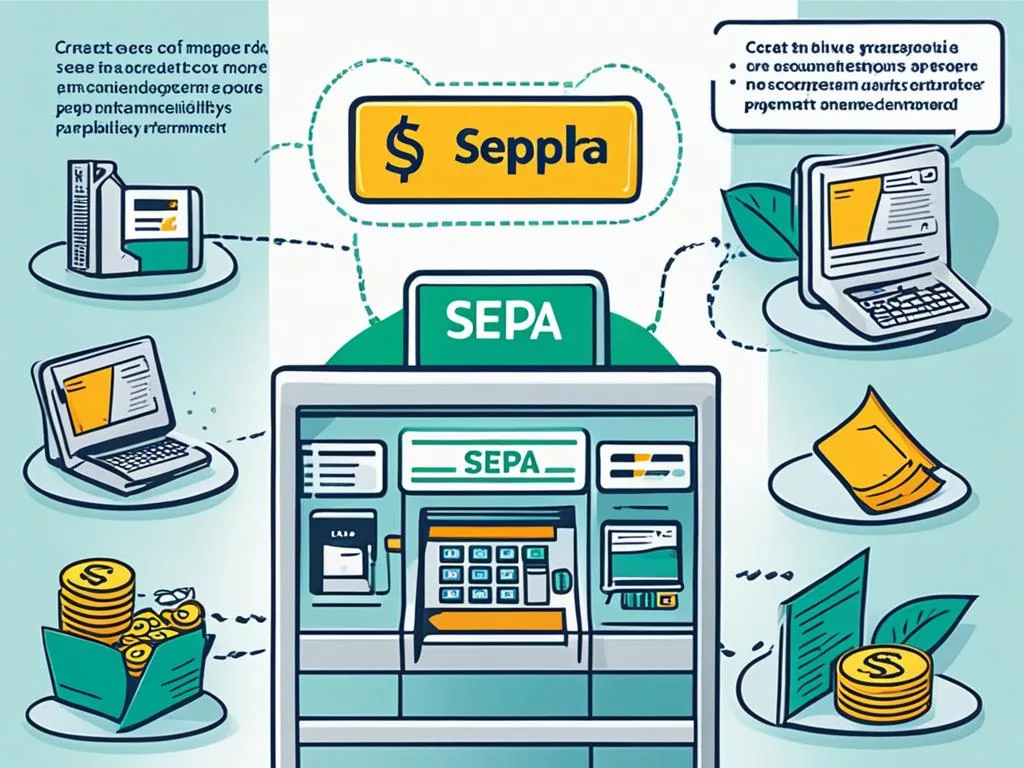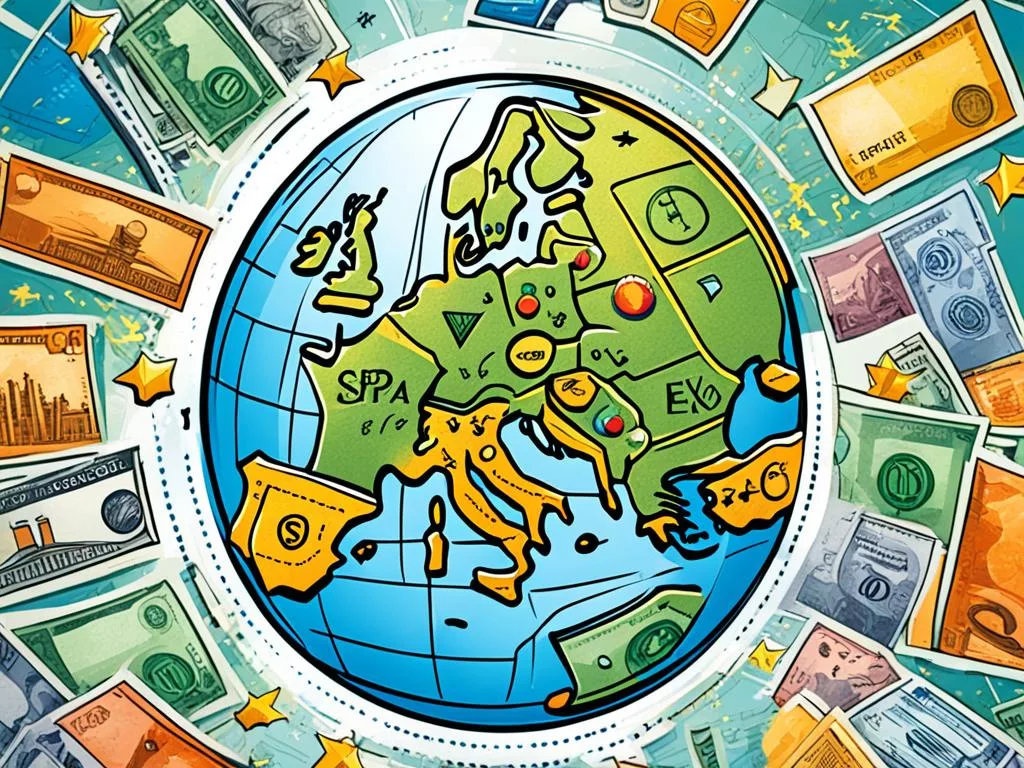As I reminisce about the days of rummaging through my wallet for crisp bills to send overseas, I’m reminded of the revolution in the palm of my hand – my smartphone. With a few taps, I can now navigate the seas of online banking transfer Europe with ease, embracing the SEPA payment system that feels less like a financial chore and more like sending a message to a friend across the world. Gone are the overwhelming fees of traditional international bank transfers that once could cost more than €30, plus a 5-7% margin on exchange rates1. Now, I bask in the convenience and savings provided by the digital age, sharing the gift of money with family, friends, and businesses thousands of miles away without the hefty price tag or the wait.
My personal transition to digital money solutions mirrors a broader shift as European bank money transfer methods evolve. Like many others, I’ve discovered that transactions with online money transfer providers typically wrap up within 1-2 days on average1. The thought of helping others bypass steep money operator charges, which can scoop up 5% or more of the transfer amount for international wire transfers1, is immensely fulfilling. With each successful transfer, I feel part of a movement toward financial empowerment—a journey flanked by 24-hour support and savvy online tools offered by foreign exchange companies1.
I share these insights not just to spread the word but to knit us closer together in a web of seamless, borderless transactions. The power to support and connect with one another financially is a testament to our shared ingenuity and resolve. As we forge ahead, I am buoyed by the certainty that our financial paths are growing ever more interconnected, thanks to the innovative European bank money transfer avenues at our fingertips.
Understanding European Bank Money Transfer Options
As a copywriting journalist focusing on the ever-evolving world of international finance, I’ve found that exploring international money transfer options holds the key to unlocking cost-effective and efficient transactions. Companies like MoneyGram and Western Union have broadened the reach of their services, now encompassing a tapestry of nations, thereby providing a myriad of payment avenues including bank transfers, cash pickups, and even digital operations2. Such diversification in service delivery has unequivocally redefined the concept of money transfer fees in Europe, offering competitive rates to consumers.
In my analysis of currency exchange rates in Europe, I’ve noted that the emergence of financial entities like OFX has been pivotal. OFX has notably eradicated transfer fees and provides rapid transaction capabilities, promising a delivery window spanning from a single day to three, subject to the destination — without imposing upper transfer ceilings3. This results in palpable savings and heightened accessibility for end-users, suggesting a transformative shift in the international money transfer landscape.
While contemplating the available choices, it is imperative to consider the velocity of transactional processes. Services like Xoom, a subsidiary of PayPal, stand out for their swift transfer turnarounds, potentially finalized in mere minutes, and allow for funding through PayPal balances4. Meanwhile, with over 50 deliverable currencies and the option of a debit card, Wise offers an innovative borderless account that exemplifies the modern-day versatility in currency exchanges and access.
Let’s delve into a comparative analysis:
| Service | Coverage | Delivery Methods | Transfer Speed | Additional Features |
|---|---|---|---|---|
| MoneyGram | Global | Bank transfers, Cash pickups, App | 1-5 days | Multiple currency offerings |
| Western Union | Global | Bank transfers, Cash pickups, Online | Instant to several days | Extensive agent network |
| Wise | Over 50 currencies | Bank transfers, Debit card | Instant to a few days | Borderless account |
| Xoom | Over 160 countries and territories | PayPal, Bank transfers | Minutes to a day | Backed by PayPal |
| OFX | Varies by currency | Bank transfers | 1-3 business days | No transfer fees |

In conclusion, the integration of these diverse international money transfer options for European citizens and expatriates alike, offers an array of choices designed to suit varying needs and preferences. This assessment should empower individuals and organizations to make more informed decisions that align with their financial goals and emphasizes the significance of comprehensive market research when navigating the intricacies of cross-border monetary movement2.
What is the Best Way to Transfer Money From a Bank in Europe?
When considering the best way to transfer money from a bank in Europe, it’s important to weigh factors such as costs, transfer speed, and the convenience of different methods. One aspect of international money transfers to consider is the SEPA payment system, which streamlines transfers within the European Union, but may not be as beneficial for transfers outside of the EU. In such cases, established services like Wise and MoneyGram are preferred for their efficiency and lower fees.
Wire transfer fees for outgoing transactions from European banks can be steep, averaging around $44, with transfer speeds typically at 24 hours or the next business day5. In contrast, nonbank services like Wise significantly undercut these fees, charging approximately $6.42 for international money transfers, with funds reaching their destination within 1-2 business days in most cases5. Furthermore, Xoom’s integration with PayPal provides recipients swift access to funds, often within minutes, and allows for substantial transfers of up to $50,000 per day, though they apply a 5% fee plus a fixed currency fee5.
In terms of accessibility and affordability, MoneyGram typically sets a low bar for transfers using a debit card, charging only $1.99 and completing transactions by the next business day, albeit with a maximum of $10,000 per transaction5. Contrastingly, international wire transfers from banks are not only slower but also come with higher fees, whereas nonbank services offer not only lower fees but also reasonable delivery speeds, making them a more economic choice5.
However, if you’re an expat or frequently conduct international business, the efficiency of TransferWise might be unrivaled. With 30% of their payments sent in under 20 seconds6 and the convenience of a multi-currency account that allows customers to manage up to 55 different currencies6, it’s a service designed for a global lifestyle. For digital banking within Europe, Revolut and N26 present intriguing options, with various membership plans and perks like free ATM withdrawals up to a certain limit and free transfers within their network6.
Ultimately, your choice will hinge on your priorities—whether it be transfer speed, fees, or maximum transfer limits. To identify the most effective avenue for your next international money transfer, leveraging platforms like Monito can be invaluable. This money transfer comparison site offers real-time transfer fees and exchange rates from popular services, empowering you to find the best rates available for your specific transfer needs6.

SEPA Payment System Explained
The advent of the SEPA payment system has revolutionized how money is moved across Europe, creating a unified framework that encompasses an impressive 36 countries7. This includes not only the 27 EU member states but also extends to the four European Free Trade Association member states, the United Kingdom, and even microstates such as Andorra, Monaco, San Marino, and Vatican City7. The intent behind SEPA is clear: to reduce the cost of capital movement within Europe’s economy significantly, with aims to slash expenses by up to 2-3% of the total GDP as observed from data in 20077.
This ambitious objective also finds its roots in the establishment of key milestones and services. Most notably, SEPA introduced payment instruments that have become staples, such as pan-European credit transfers launched in 2008 and direct debits in 20097. For everyday consumers and businesses alike, SEPA Credit Transfer (SCT) ensures that payments made before the cut-off point on a working day are credited to the recipient by the next business day, streamlining transactions significantly7. Furthermore, the SEPA Instant Credit Transfer (SCT Inst) service exemplifies efficiency with payees being credited within a mere 10-20 seconds7.
- SEPA Direct Debit offers not one but two distinct schemes: Core SDD for consumer use and B2B SDD designed for businesses, illustrating the system’s flexibility7.
- Under SEPA, transfer times are guaranteed, and banks are not permitted to deduct any amount from transfers7.
- A core principle, labeled under the EC 924/2009 regulation, mandates that charges for cross-border euro payments between EU member states remain equal to domestic payments7.
The far-reaching benefits of the SEPA payment system have not gone unnoticed outside the eurozone. Remarkably, countries such as Sweden and Romania have voluntarily chosen to align their national and cross-border payment charges, even when transactions are conducted in their own currency8. Moreover, the European Commission expanded the system’s reach further in April 2018, proposing that all EU citizens, regardless of whether their country uses the euro, should reap the same benefits of making cross-border payments at domestic costs8.
| Service | Coverage | Transfer Speed | Transaction Limit |
|---|---|---|---|
| SEPA Credit Transfer (SCT) | 36 European Countries7 | Next Working Day7 | Up to €999,999,999.99 |
| SEPA Instant Credit Transfer (SCT Inst) | 27 EU Members & More7 | 10-20 Seconds7 | Up to €100,000 |
| SEPA Direct Debit (Core SDD/B2B SDD) | EU & Select Non-EU7 | Guaranteed time | No Maximum Limit |
These features not only solidify SEPA’s position in providing an array of international money transfer options but also highlight its role as a cornerstone in facilitating cross-border electronic payments in euro within the entire EU and beyond, including Andorra, Iceland, Norway, Switzerland, among others8.

Breaking Down International Money Transfer Options
As I navigate the complexities of international finance, I’ve found that understanding the nuances of remittance services in Europe is key. For instance, IBAN’s structured format, consisting of a country code, check digits, and up to 35 alphanumeric characters, streamlines the process of cross-border European banking transfers9. Exploring the world of money transfers, it’s evident that utilizing services like Wise, which charges substantially less than traditional wire transfer fees in Europe, can lead to significant savings. More and more, technology-driven platforms are transforming currency exchange rates in Europe, offering speed and efficiency that traditional methods struggle to match.
Turning my attention to the SEPA payment system, it’s fascinating to see how it has democratized payment costs, ensuring equity by mandating that payments in euros within the EU have the same cost as domestic payments10. Moreover, options for managing fees, like Barclays provides, allow for adaptable solutions when dealing with international payments, catering to a diverse clientele across more than 200 countries11. It’s notable that North American, Australian, and Asian countries, while not using IBAN for domestic purposes, are part of the growing tapestry of global finance by recognizing it for international payments9.
In my continual quest to provide comprehensive financial insights, I observe that whether one engages in wire transfers in Europe or opts for other remittance services, understanding the intricacies of these options—including their fees, speed, and international coverage—is imperative. It goes without saying that becoming acquainted with the terms and conditions of the varied transfer methods available, from the SEPA system’s congruence with EU legislation10, to the global outreach of providers such as MoneyGram and Western Union, equips one with the knowledge to navigate the global financial landscape astutely.
Source Links
- https://www.expatica.com/global/finance/money-management/international-money-transfers-108328/
- https://www.bankofengland.co.uk/payment-and-settlement/cross-border-payments
- https://www.td.com/ca/en/personal-banking/how-to/td-app/register-send-money-with-td-global-transfer
- https://www.westernunion.com/blog/en/fr-2/how-to-receive-a-bank-transfer-from-abroad/
- https://www.bankrate.com/banking/international-money-transfer/
- https://www.forbes.com/advisor/money-transfer/4-great-ways-for-expats-to-manage-and-transfer-money/
- https://en.wikipedia.org/wiki/Single_Euro_Payments_Area
- https://finance.ec.europa.eu/consumer-finance-and-payments/payment-services/single-euro-payments-area-sepa_en
- https://www.investopedia.com/terms/i/iban.asp
- https://www.europa.eu/youreurope/citizens/consumers/financial-products-and-services/payments-transfers-cheques/index_en.htm
- https://www.barclays.co.uk/ways-to-bank/international-payments/

